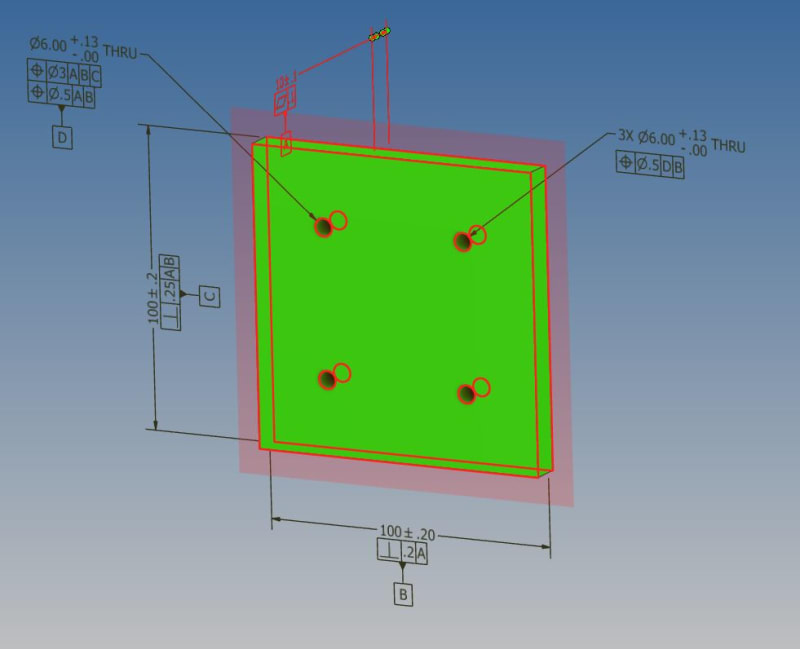The use of leading zero or not as a convention for telling inch from metric based dimensions on the decimal fractions is just an amusing thing. I prefer the use of leading zeros when the decimal point might get missed - that's the primary reason for it so that 100+/-25 isn't converted by a smudge to 100+/-.25, but ASME finds it acceptable to risk that confusion for inch dimension users, possibly because they hate the use of inches.
Went and looked it up for Creo:
lead_trail_zeros
controls the display of leading and trailing zeros in dimensions.
default and available settings
[ul]
[li]std_default* - displays trailing and leading zeros based on the model unit system. if you set the model units to metric system, only the leading zeros appear ignoring the trailing zeros. similarly, if you set the model units to english system, only the leading zeros appear ignoring the trailing zeros.[/li]
[li]std_metric - displays only leading zeros. trailing zeros are not displayed.[/li]
[li]std_english - displays only trailing zeros. leading zeros are not displayed.[/li]
[li]both - both leading and trailing zeros are displayed.[/li]
[/ul]
So, it is possible metric values are used with a model set to the English system units.
There are more effects noted at
I would not say unprofessional, I would instead say it leaves the chance for a handwritten copy to be misread. On the computer it's a convention without purpose but to provide a "you did it wrong" target, an observation that adds no value.
This is why I write sevens as
7 and 0 with a diagonal slash, to ensure they aren't confused with a 1 and a capital O, but don't use those when typing on a computer.
---
On the topic of conventions:
At one time typed business letters were considered unprofessional, an actual insult to the recipient.
Now that people use computers and the decimal point isn't going anywhere then it is like using what looks like a stylized "f", the long s symbol. It's archaic, but many people like to keep the old around.
From the Wikipedia entry on the long s:
Long s was always used ("ſong", "ſubſtitute") except:
[ul]
[li]Upper-case letters are always the round S; there is no upper-case long s.[/li]
[li]A round s was always used at the end of a word ending with ⟨s⟩: "his", "complains", "ſucceſs"[/li]
[li]However, long s was maintained in abbreviations such as "ſ." for "ſubſtantive" (substantive), and "Geneſ." for "Geneſis" (Genesis).[/li]
[li]Before an apostrophe (indicating an omitted letter), a round s was used: "us'd" and "clos'd".[/li]
[li]Before or after an f, a round s was used: "offset", "ſatisfaction".[/li]
[li]In the 17th and early 18th centuries, the round s was used before k and b: "ask", "husband", Ailesbury, Salisbury, Shaftsbury;[4] in the late 18th century: "aſk", "huſband", "Aileſbury", "Saliſbury" "Shaftſbury".[/li]
[li]These two exceptions applied only if the letters were physically adjacent on the page, and long s was used if the two were separated by a hyphen and line break, e.g. "off-ſet", "Saliſ-bury".[/li]
[li]There were no special exceptions for a double s. The first s was always long, while the second was long in mid-word (e.g. "poſſeſſion"), or short when at the end of a word (e.g. "poſſeſs"). See, for example, the word "Bleſſings" in the Preamble to the United States Constitution.[/li]
[li]Round s was used at the end of each word in a hyphenated compound word: "croſs-piece".[/li]
[li]In the case of a triple s, such words were normally hyphenated with a round s, e.g. "croſs-ſtitch", but a round s was used even if the hyphen was omitted: "croſsſtitch".[/li]
[/ul]
In handwriting, these rules did not apply—the long s was usually confined to preceding a round s, either in the middle or at the end of a word—for example, "aſsure", "bleſsings".


